How to Zero a Red Dot Sight
Posted by 80-Lower.com on Jul 29th 2021
Just bought a red dot sight? You must zero the reticle so your point of aim (POA) matches your bullet's point of impact (POI). When you install your new red dot, chances are POA will not match POI. Your rounds may land low and left, high and right, or any combination thereof. Getting POA to match POI means making some adjustments to the turrets on your optic.
How Sighting in a Red Dot Works
When you look through a red dot, you're seeing a laser projected onto the target. No matter the distance between the target and the optic, the laser's point travels in a straight line. But bullets don't travel in a straight line. They arc, traveling upward and then falling back down. The goal of zeroing is to make the bullet's arc match your red dot's point at a known distance, so the two points (POA and POI) meet, as illustrated below:
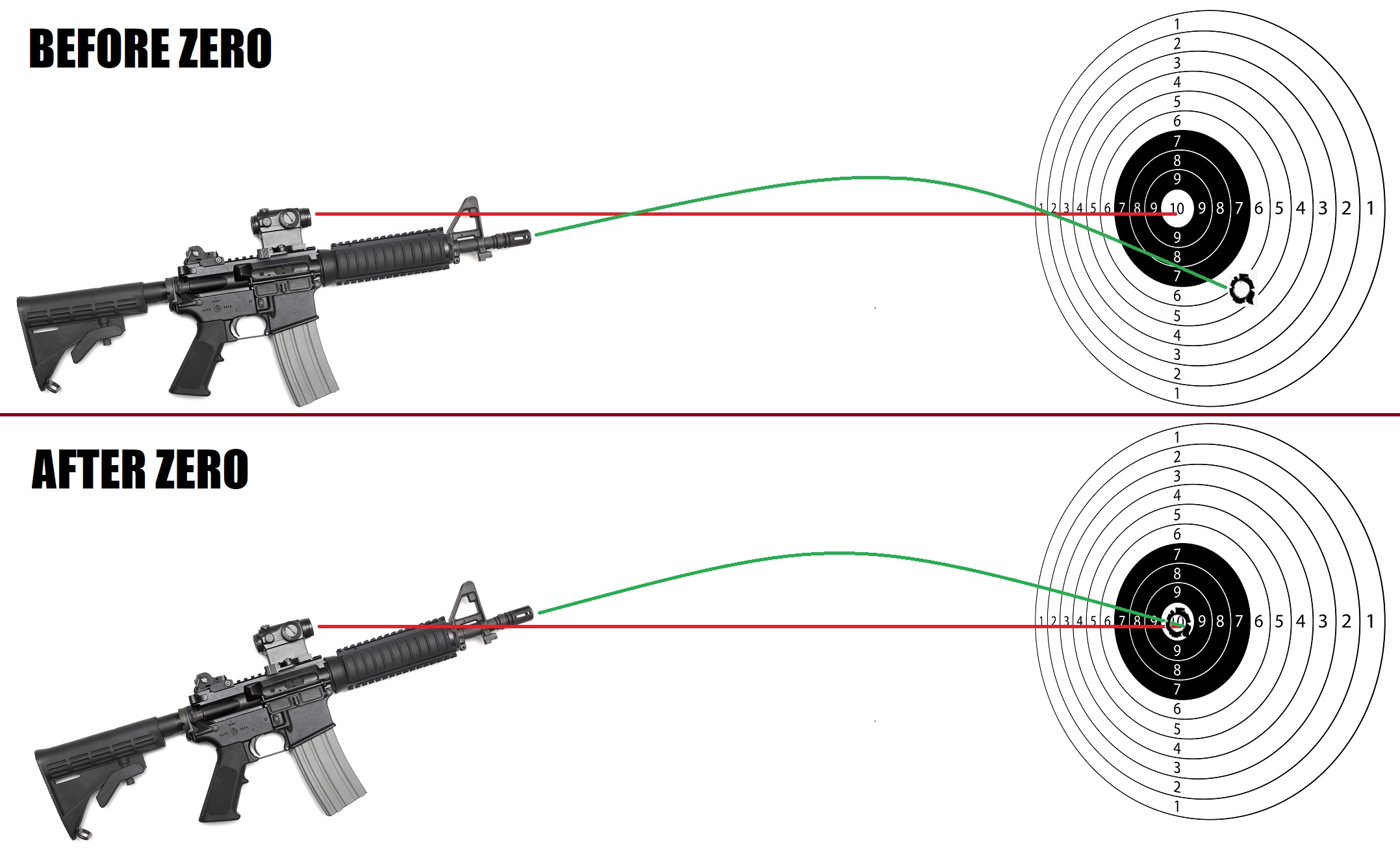
Before zeroing, the red dot's position in the example above is high and left relative to the barrel's orientation. The barrel's position is what affects the bullet's flight path. So, when the dot's placed at the center of the target and a round is sent downrange, the bullet will strike the target low and right of the bull's eye. By adjusting the turrets on the optic so the red dot is brought also down and right, the barrel's orientation will match the dot's position. POA will match POI at this distance.
Understanding MOA
Before we get into how to zero your red dot, you need to learn what minute of angle is. Expressed as MOA, this is the angular difference between an optic's point of aim and a bullet's point of impact.
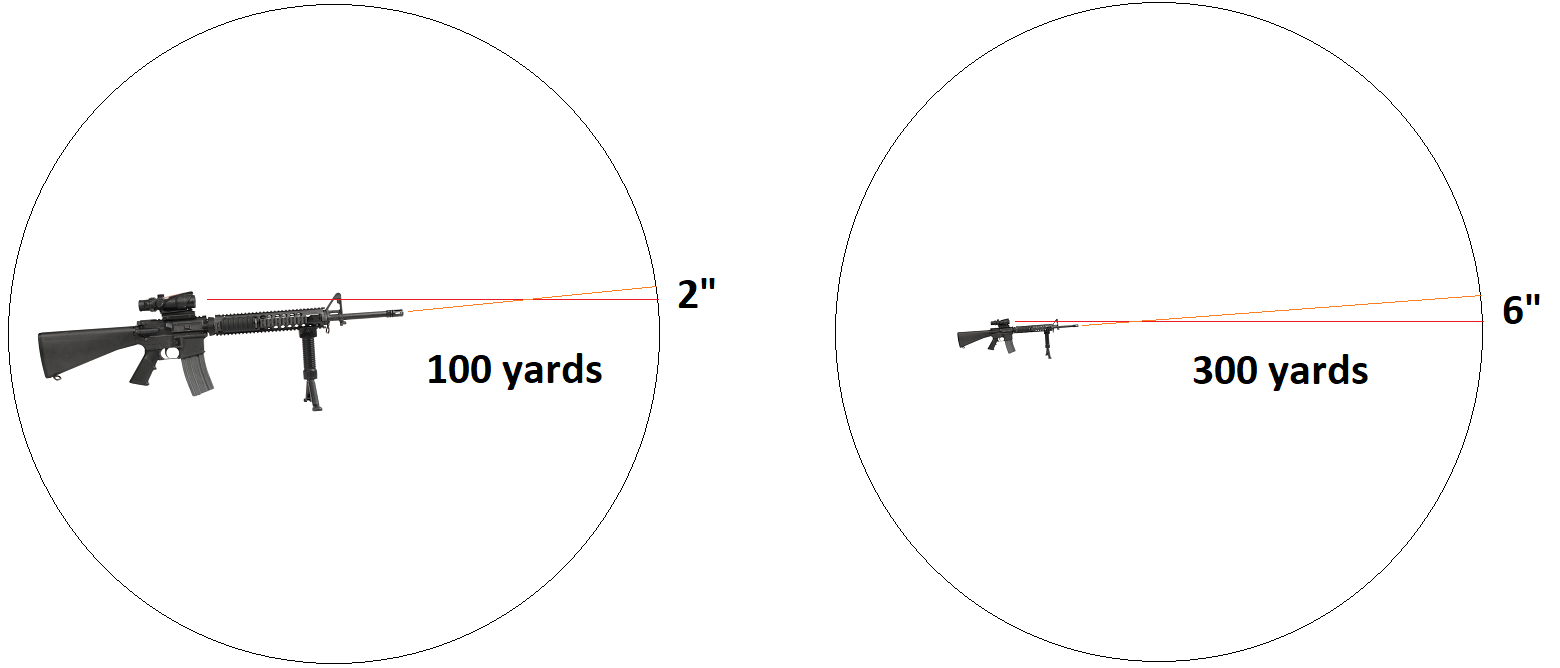
Without factoring in things like elevation, wind, and bullet drop, the difference between point of aim and point of impact forms an angle. This angle gets bigger as distance increases. Minute of angle measures the rate at which that happens. A smaller minute of angle means a smaller difference between aim and impact as distance increases, which means better accuracy. A shot group that's 1 MOA wide will spread 1" at 100 yards, 2" at 200 yards, 3" at 300 yards, and so on. In our example above, the rifle is shooting 2 MOA. That means a 2" grouping at 100 yards, 4" at 200 yards, 6" at 300 yards, and so on.
Formula to calculate MOA
To calculate MOA, you must measure differences in inches at known distances. Use the two formulas below. The first one measures general accuracy, like above.
((Size of shot group in inches) / (distance to target in yards)) * 100.
If you're zeroing using a red dot or you just want to know the difference between aim and impact for a single shot, the formula changes a little:
((Difference in inches between aim and impact) / (distance to target in yards)) * 100.
Formula to calculate inches per MOA
(Distance to target in yards) / 100.
If you can observe how many inches off center your rounds are impacting your target at a specific distance, then all you need to calculate is how many inches your turrets will move your point of aim per click. We'll get into examples using this formula below.
Most Red Dots use MOA Turrets
The turrets on your optic are used to adjust point of aim by physically adjusting the red dot in the center of the reticle. MOA turrets usually provide 1/4, 1/2, or 1-MOA adjustments. We like 1/2 adjustments, like those found on the Holosun MRS Red Dot. It provides a good compromise between very fine adjustments and simple calculations.
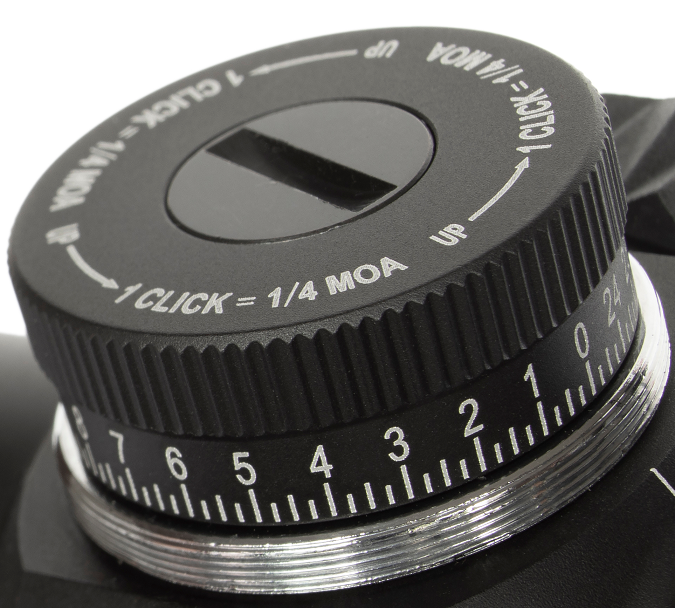
Don't worry about how these work just yet. We'll show how to convert the differences between aim and impact into adjustments using MOA turrets below. Let's look at what tools you'll need at the range to zero.
Tools for Effectively Zeroing
How do you easily observe the differences (in inches) between point of aim and point of impact so you can calculate your adjustments? There are two tools you can use to zero a red dot, and we recommend using both to guarantee an accurate zero without wasting ammo.
Laser Boresight

Chances are high that when you install your new red dot, the optic will be far off from a good zero. When shooting at a target just 25 or 50 yards away, you may miss entirely. You have to able to hit the target to make your measurements and adjust your reticle. To get on paper, we recommend starting off with a boresight. A boresight shines a laser through the barrel to simulate where a live round might impact.
You can get a relatively cheap and simple chamber boresight. These look like a shell casing with a laser built inside, like the Tacticon Boresight. For zeroing further out, you can invest in a muzzle boresight like the SiteLite Mag Laser. Lasers like the SiteLite use a stronger diode and they tend to provide a bit more of an accurate representation of point of impact for a higher price.
Zeroing / Sighting Target
A boresight will only get you on paper at a relatively close distance. Lasers travels in a straight line, but bullets don't. Try and zero with only a boresight beyond 50 yards or so, and your rounds will land below your point of aim. To truly zero, you need to shoot a target and observe the real difference between your point of aim and bullet impact.
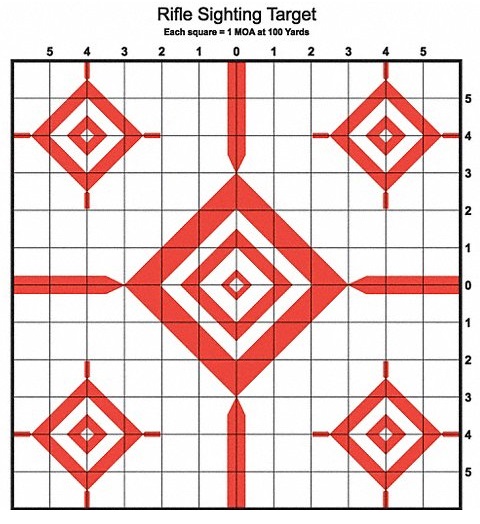
A grid target, sighting target, or zeroing target uses one-inch squares to provide an easy way to measure how far off the center of the target your bullet impact is relative to your aim. Place this target at 100 yards, and each 1" box represents 1 MOA. Place it at 50 yards, and each box represents 2 MOA. At 25 yards, each box is 4 MOA.
How to Zero Your Red Dot
It's finally time to look at some examples. We'll use a grid target at different known distances, and we'll cover making adjustments using 1, 1/2, and 1/4-MOA turrets.
25 Yards
The 25-yard zero is arguably the easiest and most effective for personal defense, close-quarters shooting, and obtaining accuracy at any indoor range. At this distance, you'll retain a nearly flat bullet trajectory within 50 yards. Because of how the bullet's flight path is affected by the 25-yard zero, you'll also tend to hit a bull's eye at 5 and 12 yards for most handgun and rifle loads without further adjustments. Let's look at an example or two.
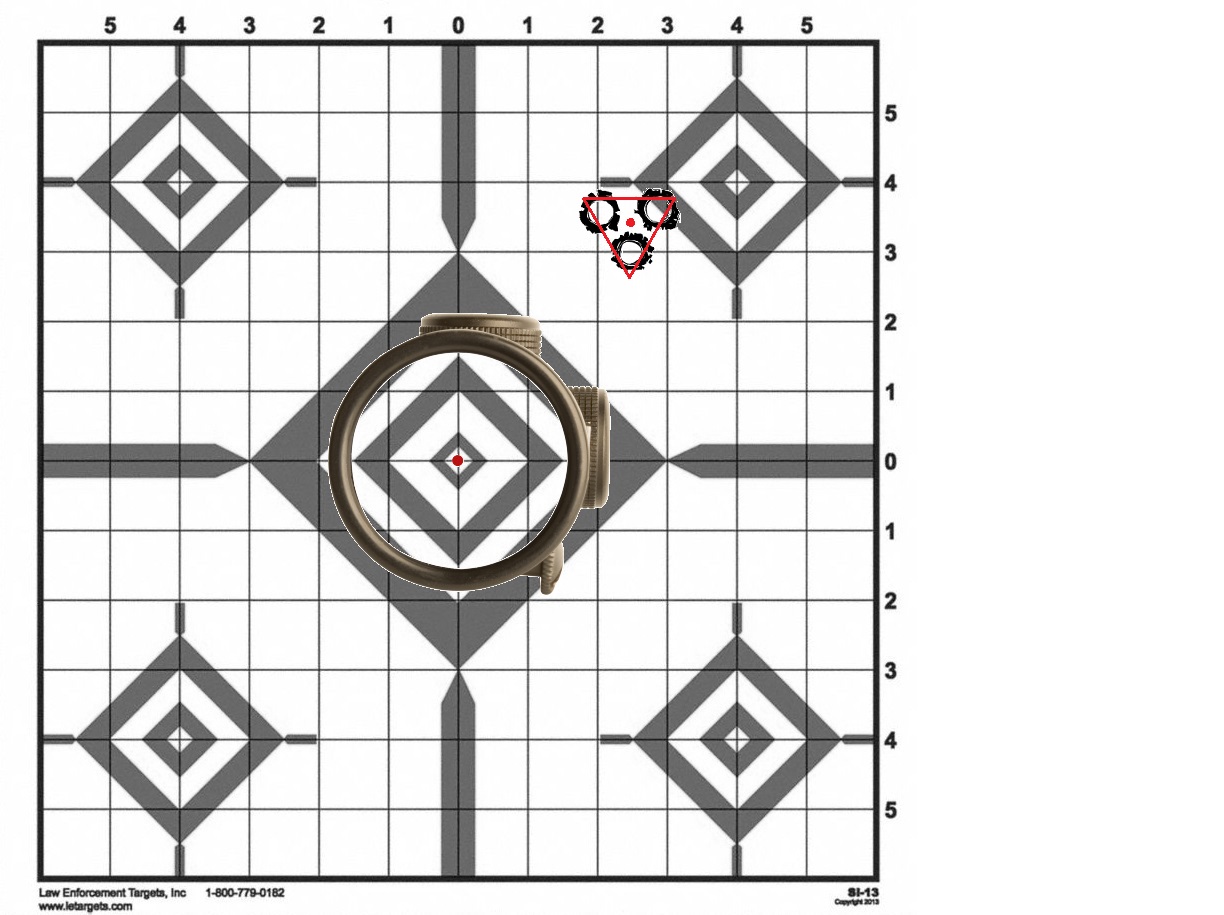
Placing our red dot at the center and firing a three-shot group, we find that we're shooting 2.5 inches right and 3.5 inches high. Let's use the formula from earlier to calculate inches per MOA at this distance:
(Distance to target in yards) / 100 = X inches per MOA.
(25 yards) / 100 = 0.25 inches per MOA.
If we divide 2.5" by 0.25", we find we need 10 MOA of lateral adjustment to move the bullet's impact left. If we take 3.5" and divide it by 0.25", we get 14 MOA of vertical adjustment required to move the bullet's impact downward.
On a turret with 1-MOA clicks, perform 10 clicks left on the side turret, and 14 clicks down on the top turret. Using a 1/2-MOA turret? Multiply your clicks by two. For a 1/4-MOA turret, multiply by four.
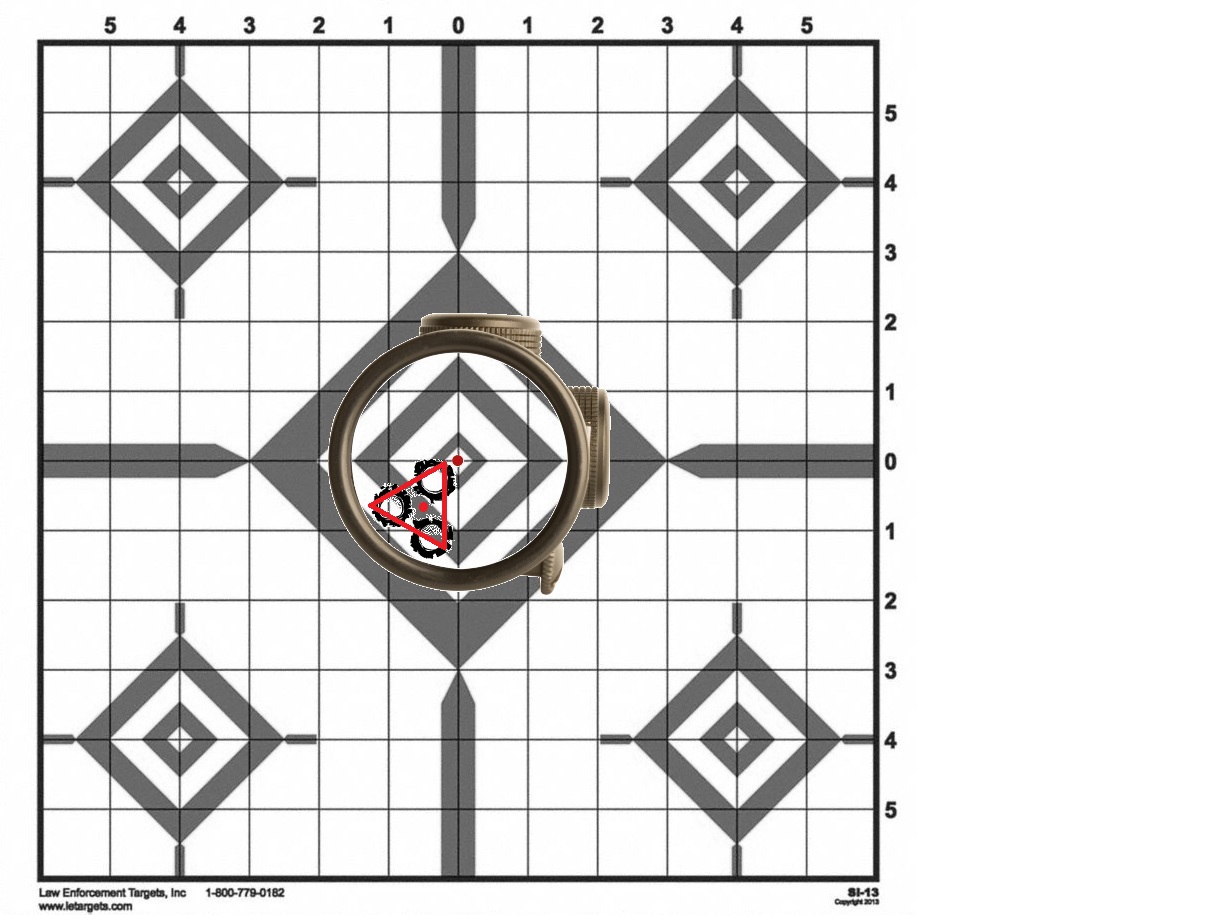
After making adjustments, we fire another three-shot group. We're approximately 0.5" low and left of the target. Using the data from above (0.25" per MOA), we need to adjust 2 MOA (0.5" / 0.25") of right and up. On 1-MOA turrets, that's two clicks right and two clicks up. On 1/2-MOA turrets, that's 4 clicks up and right. 1/4-MOA turrets, that's 8 clicks up and right. At this point, you would perform a final three-shot group to confirm your point of impact matches your red dot's point of aim.
36 Yards
The 36-yard zero is used by the United States Marine Corp because it allows for point-blank and long-range engagements with little need for adjustments. That's because at 300 yards, aim will match point of impact.
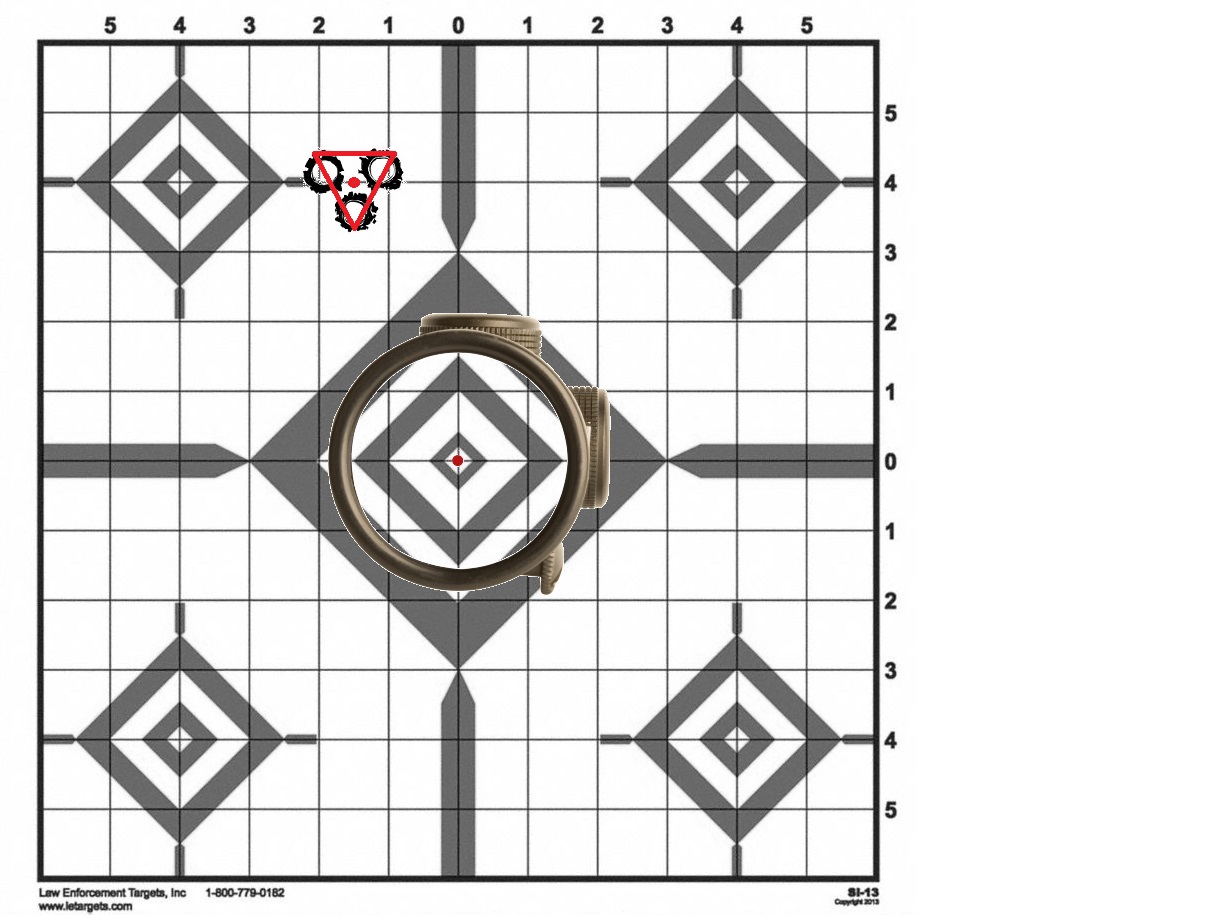
We observe the shot group is 1.5" left and 4" high. At 36 yards, we're working with 0.36" per MOA. Dividing 1.5" by 0.36" we get about 4.2 MOA left. Dividing 4" by 0.36" we get about 11.1 MOA high. If you wind up with odd, partial numbers like this, round to the nearest adjustment. With 1/4-MOA turrets, we'd adjust right 17 clicks (4.25 MOA) and we'd adjust down 44 clicks (11 MOA). For 1/2- and 1-MOA turrets, we'd round to 4 MOA and 11 MOA.
50 Yards
The 50-yard zero is one of the most popular for law enforcement, most rifleman, and hunters. With this zero, bullet trajectory remains relatively flat out to 300 yards for most rifle cartridges, especially for .308 Win, and .223 and 5.56 NATO. Point of aim will match point of impact at 200 yards with no adjustments, too.
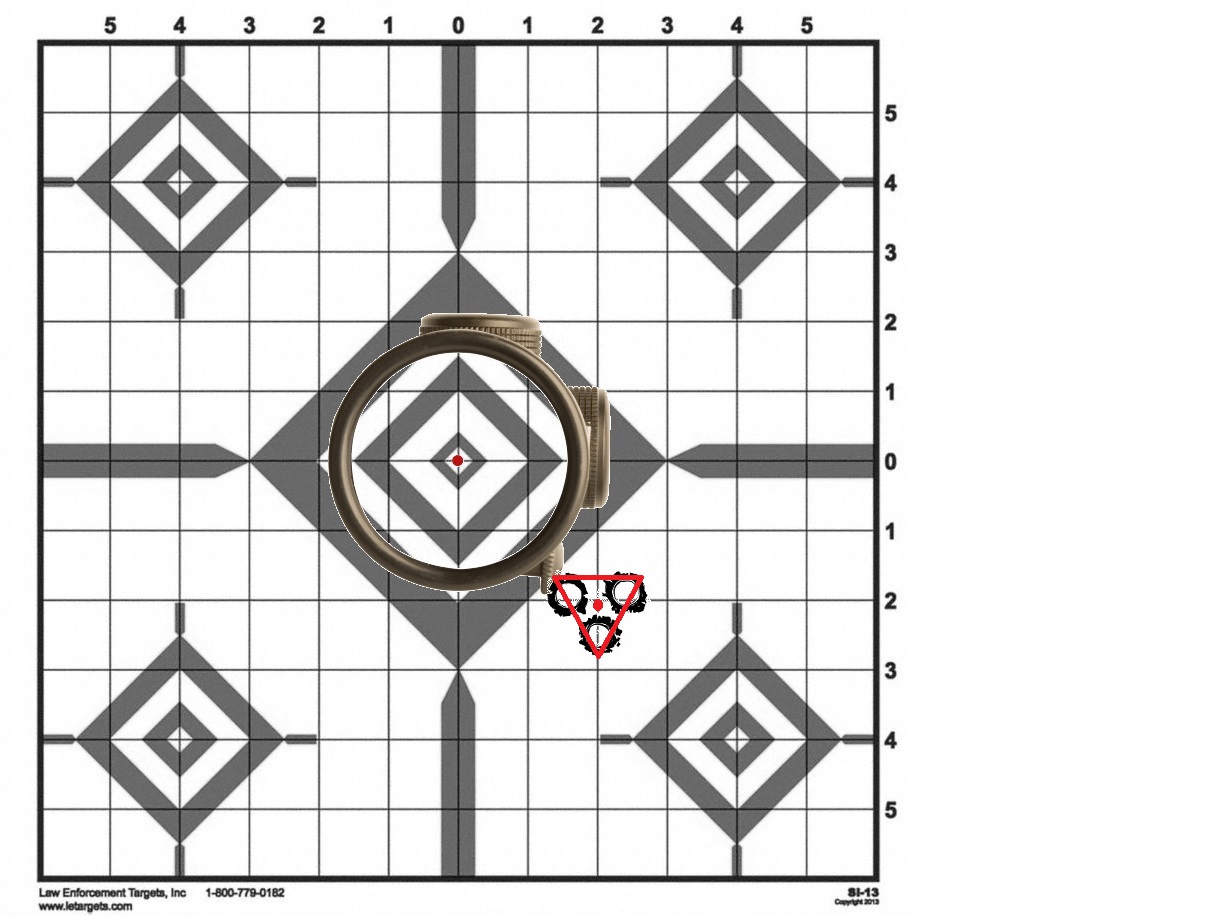
Again, calculate inches per MOA: (50 yards) / 100 = 0.5" per MOA. Now observe how many inches off-center the shot group impacted: We're 2" right and 2" low. Now convert that to MOA: 2" divided 0.5" = 4 MOA right and 4 MOA low. On 1/4-MOA turrets, make 16 clicks up and left. On 1/2 turrets, make 8 clicks up and left. On 1-MOA turrets, 4 clicks up and left. Easy.
FAQ
Q: Can I use these instructions to zero other optics?
A: Yes. If it has MOA turrets, any optic or scope can be zeroed using these instructions and formulas.
Q: Which direction do I rotate my turrets to zero my red dot?
A: Always turn the turrets in the direction you want to shift your point of impact, not your point of aim. If your rounds are landing right of the center of the target, you want to click the side turret to the left. If you're shooting high, you want to click the top turret down.Turrets always mark which direction is right/left and up/down.
Q: What if I'm using a red dot with variable zoom?
A: Magnification doesn't affect the adjustments you make when zeroing. You can zero at any magnification.
Q: Does my sight picture affect my point aim or zero?
A: For red dots, point of aim remains the same regardless of your sight picture. Red dot sights are free of parallax error. That means no matter where your targeting eye is placed behind the reticle, the dot's aim will not change
Q: How often should I zero my weapon?
A: You should re-zero any time you remove and reinstall your red dot or optic. If you change ammunition - especially bullet weight - you should also re-zero. Large temperature changes can affect laser diodes. It's good practice to zero when moving from cold to hot environments, and vice versa.
Recap
We covered a lot of information that was technical. Here's a simple summary of how to zero your red dot:
1. Fire a three-shot group at a target at a known distance (25, 36, 50, or even 100 yards).
2. Measure the distance between the shot group and target's center in inches.
3. Calculate inches per MOA at that distance (distance to target in yards / 100).
4. Divide the shot group's distance in inches from the target's center by inches per MOA.
5. This calculation provides the distance from the target's center in MOA.
6. Make your up/down and left/right MOA adjustments using your turrets.
7. If using 1/4-MOA turrets, multiply your calculation by 4 to get the number of clicks required.
DISCLAIMER: If you are new to the world of DIY gun building, you likely have a lot of questions and rightfully so. It’s an area that has a lot of questions that, without the correct answers, could have some serious implications. At GunBuilders.com, we are by no means providing this content on our website to serve as legal advice or legal counsel. We encourage each and every builder to perform their own research around their respective State laws as well as educating themselves on the Federal laws. When performing your own research, please be sure that you are getting your information from a reliable source.

